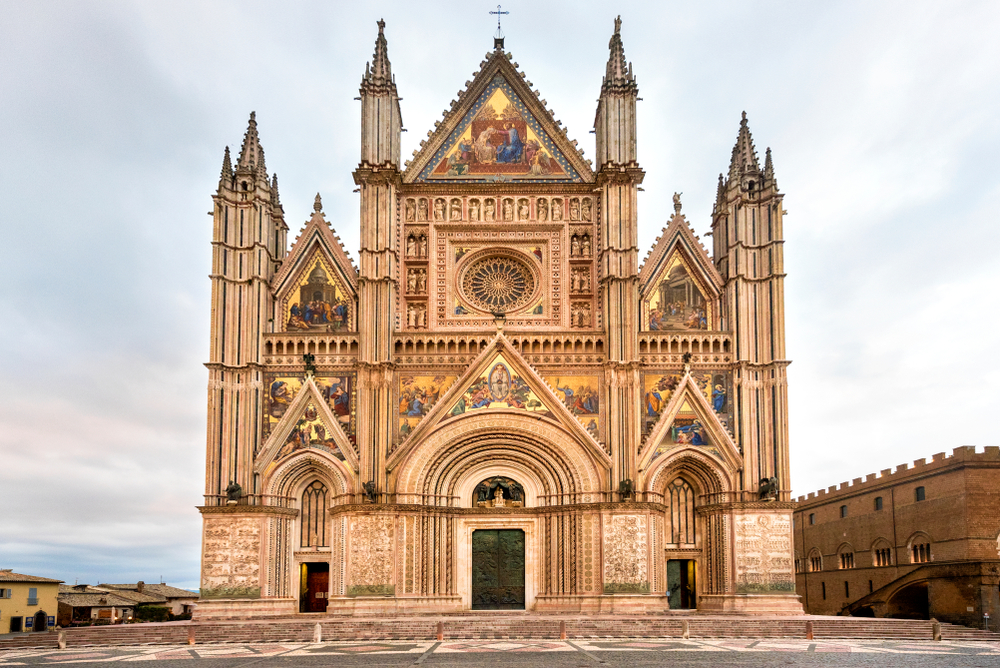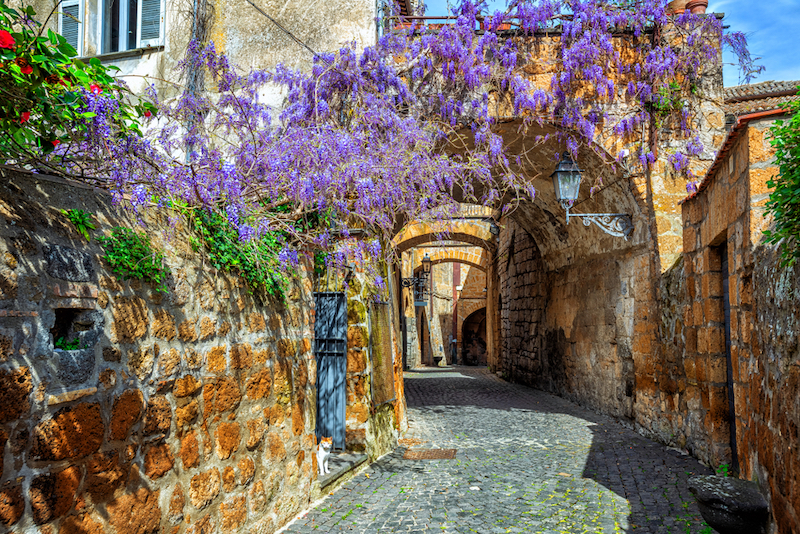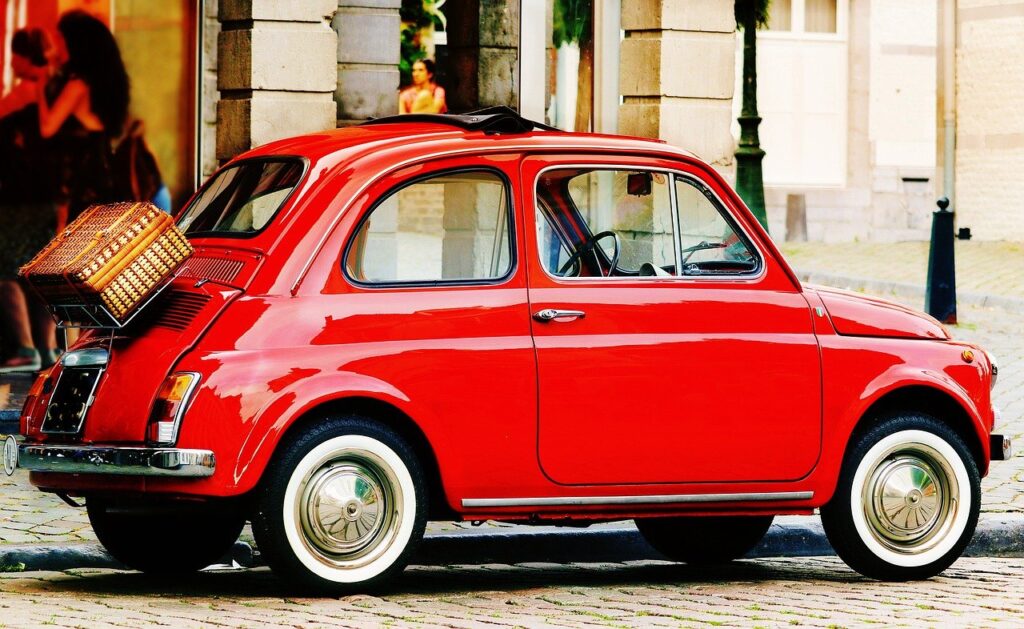Guide to Orvieto: What to see and do in Orvieto
Situated in the province of Terni in the South West of Umbria, Orvieto is one of Umbria’s most beautiful cities, certainly if you find yourself in the enchanting older, historic elevated hilltop area. (There is also a more modern lower part constructed after WWII which doesn’t have the same shine to it). Perched on tufa (limestone) rocks, it is famous for its wine, Umbricelli pasta, black truffles and olive oil, as well as being rich in art and architecture.
What to do in Orvieto
Orvieto is one of those towns where you could lose yourself for hours just exploring its charming narrow streets, browsing in its independent shops, admiring its stunning churches and revelling it its fascinating museums, and historic palaces.
Orvieto’s 14th century Duomo must be its most famous sight. This impressive spectacle is arguably one of the greatest Gothic buildings in Italy but it does also has Romanesque influences. Its facade is simply stunning, decorated with a series of mosaics which tell the story of the Virgin Mary including various scenes from her life including the nativity, presentation of Mary in the temple and assumption into heaven. Also of note on the facade, high in its centre, is the beautiful Rose Window by Andrea di Cione, surrounded by sculptures representing, amongst others, the 12 prophets and apostles. Bronze sculptures also decorate the front of the Duomo, symbolising the four Evangelists – an angel for St Matthew, a lion for St Mark, an eagle for St John and a bull for St Luke – whilst there is a bronze sculpture above the central door of the Virgin and Child. These central doors are actually not the original. The original wooden doors were replaced in 1970 by the bronze doors that you see today which were created by Sicilian sculptor Emilio Greco.

Inside the Duomo, there are some beautiful frescoes by Luca Signorelli in the San Brizio Chapel (Cappella di San Brizio) depicting the Last Judgement. There are also some important sculptural masterpieces including the statue of Pietà by Ippolito Scalza, created from a single block of marble, as well as two important statues created by Francesco Mochi in the early 600s.
There are other churches in Orvieto worth a visit too. The oldest is the Romanesque Church of San Giovenale dating back to 1004, which contains many original frescoes and which also happens to boast fantastic views from the piazza in front overlooking the Umbrian hills. Others include the 18th cave church of the Madonna del Velo, the Church of Sant Angelo, the Church of San Francesco, the Church of San Giovanni, the Church of Sant Agostino and the Church of Sant Andrea. In the basement of the latter, you will discover the remains of key periods in the history of Orvieto – the Bronze Age, Etruscan period, Roman era and, most recently, the period of Christianity in the city. All these churches are worth a visit in their own right, but it’s worth noting that there are many, many more to be discovered in Orvieto besides those listed.
There are also plenty of museums in Orvieto to enjoy too. These include the Museo Claudio Faina, the Museo Archeologico Nazionale and the Museo dell’ Opera del Duomo. The first two of these are perhaps the most interesting for ancient history lovers, each displaying a host of artefacts dating back to Etruscan times. The Opera del Duomo Museum is located on the second floor of Palazzo Soliano and provides much more detail about the building of the Duomo and its history, whilst the ground floor of this palace is dedicated to Emilio Greco (designer of the Duomo’s bronze doors) and includes an exhibition of his bronze works.
For a completely different perspective on Orvieto, make your way to the Torre del Moro. Visitors can climb its steps to reach a spectacular terrace where you can enjoy 360 views over Orvieto and beyond. Be prepared to take your time to make your way up though. If you go by foot all the way up, there are 236 steps to climb. Even if you take the lift, it will only take you part of the way, stopping at the second level, still leaving you with 160 steps left to combat! The bell at the top rings every 30 minutes.
Our favourite of Orvieto’s towers is the Torre di Maurizio though with its beautiful clock face. Look to the top of this working medieval tower to find the bell and bronze bell ringer (Maurizio) flanked by a pair of smaller bells, all on stilt-like legs. The clock originally served to provide those working on the construction of the Duomo with the time and it still works perfectly today, sounding every hour on the dot.

Adjacent to the Torre del Moro is the Palazzo dei Sette, one of a number of palaces in Orvieto. It is so named as it was home to the seven judges who represented the main trades and businesses in Orvieto in Medieval times. Once a residential home for the Pope and then the home of Antonio da Sangallo (the architect who oversaw the building of St Patrick’s well), it now hosts a number of events and exhibitions throughout the year.
Other palaces of note include the Palazzo Comunale, the Palazzo Soliano, the Palazzo Buzi, the Palazzo Simoncelli and the Palazzo del Popolo. Incidentally, this beautiful palazzo is situated in a charming piazza where you’ll find a market every Thursday and Saturday.
But don’t miss out on the opportunity to explore what is right under your feet in Orvieto too. The Grotta della Rupe is a quite extraordinary series of caves, cellars, aqueducts, quarries and tunnels that visitors can enjoy a tour of today. In total over 1200 caves have been discovered, 440 of which can be visited, some dating as far back as the Etruscan period. The history of this network of tunnels is fascinating. A guided tour will give you a glimpse into the varied uses they have had over the years, from being used as bomb shelters during WWII to being a place to keep pigeons and to press oil in earlier times. Also underground is ‘Il Labirinto di Adriano’, a series of 20 caves, wells and underground rooms that were so named thanks to the owners Adriano and Rita who discovered them in the 1970s.
Last but by no means not least, heading deep underground are a couple of wells – the Pozzo della Cava and St Patrick’s Well (Pozzo di San Patrizio). Both are open to visitors. The smaller of the two – the Pozzo della Cava – is a hand-dug well measuring 36 metres deep. Visit at Christmas time and you can witness the annual ‘Nativity in the Well’, a charming mechanised nativity scene. St Patrick’s Well measures approximately 175 feet deep and 45 foot wide. 496 steps lead to the bottom via two spiral staircases (this ingenious spiral staircase design means that one way goes up and one way goes down, ensuring that you won’t get clogged in pedestrian traffic as you make your way up and down)! These lead to a bridge from where people could access the water. Originally built for the papacy who used Orvieto as a hilltop refuge to ensure that they had water even during a siege, it’s an incredible feat of engineering… and it’s also a lovely cool spot if you’re needing to escape from the heat of the Summer sun.

Finally, Orvieto also has a rich theatrical tradition and visitors may like to see if anything is on at the Teatro Mancinelli.
Events in Orvieto
Like so many towns and cities in Italy, Orvieto has a rich annual calendar of events, split into religious celebrations, culinary, music and sporting events
The first of the religious events falls in the Spring, at the Feast of Corpus Domini. A key event in the religious calendar, the Sacro Corporale (sacred cloth) is carried though the town, accompanied by a procession where you’ll find the locals dressed in traditional Medieval costumes. This is followed a few weeks later by the Festa della Palombella, when a dove is released and flies to the Duomo. (Incidentially, this is preceeded by Orvieto in Bloom when the city is at its most colourful. And at the end of the year is the ‘Nativity in the Well’ each December.

Food events range from Orvieto con Gusto in the Autumn and Winter, where visitors will find food stalls throughout the town, to Gelati d’ Italia focused on finding the best tasting ice cream as ice cream makers converge on Orvieto from all over Italy.
Orvieto’s most famous festival is probably a musical one though – Umbria Jazz – which takes place each January with a series of concerts held in historic buildings throughout Orvieto. A different kind of musical celebration takes place in the Summer when the Umbria Regional Folk Festival celebrates the music and food of folk traditions.
Where to stay in Orvieto

Within easy reach of Orvieto is Villa Vetrichina, a stunning villa rental in Italy situated just over the border in Tuscany. Sleeping up to 14 guests, the property oozes luxury and even boasts its own private restaurant within the grounds, open only to those staying at the house. Alternatively, Podere Marone is an authentic 3 bedroom Umbria villa, situated less than a 30 minute drive from Orvieto, boasting its own private pool.
If you’d rather be in Orvieto itself, Expedia have some great hotels in Orvieto along with B&Bs.
How to travel to Orvieto
By train: It’s really easy to reach Orvieto by train. The train station is located in the Piazza Matteotti and, just beneath this, in the Piazza della Pace, there is a luggage storage available. Trains go regularly to and from Orvieto to Milan, Florence, Arezzo, Bologna, Rome and Florence. The train from Rome to Orvieto takes just an hour and from Florence, approximately 2 hours.
By bus: The bus station in Orvieto is located in the Piazza Matteotti, near both the train station and funicular. Buses tend to be good value for money, fairly punctual and run regularly to a number of nearby towns and cities, operated by two local companies – Busitalia and Cotral.

By car: Travelling by car is probably one of the easiest ways to reach Orvieto. Just leave the A1 motorway at the Orvieto toll both and follow the signs for the city centre, which is approximately 4.5 km away.
By plane: The nearest airports are Rome-Ciampino and Rome-Fiumicino. Alternatively, slightly nearer is Perugia airport which is popular with low cost airlines.
Cable car: Visitors can reach the traffic-free historic centre of Orvieto itself via a 2 minute cable car (funicular) ride. Top tip: Head down in the evening and you’ll find the track lit with lanterns.


